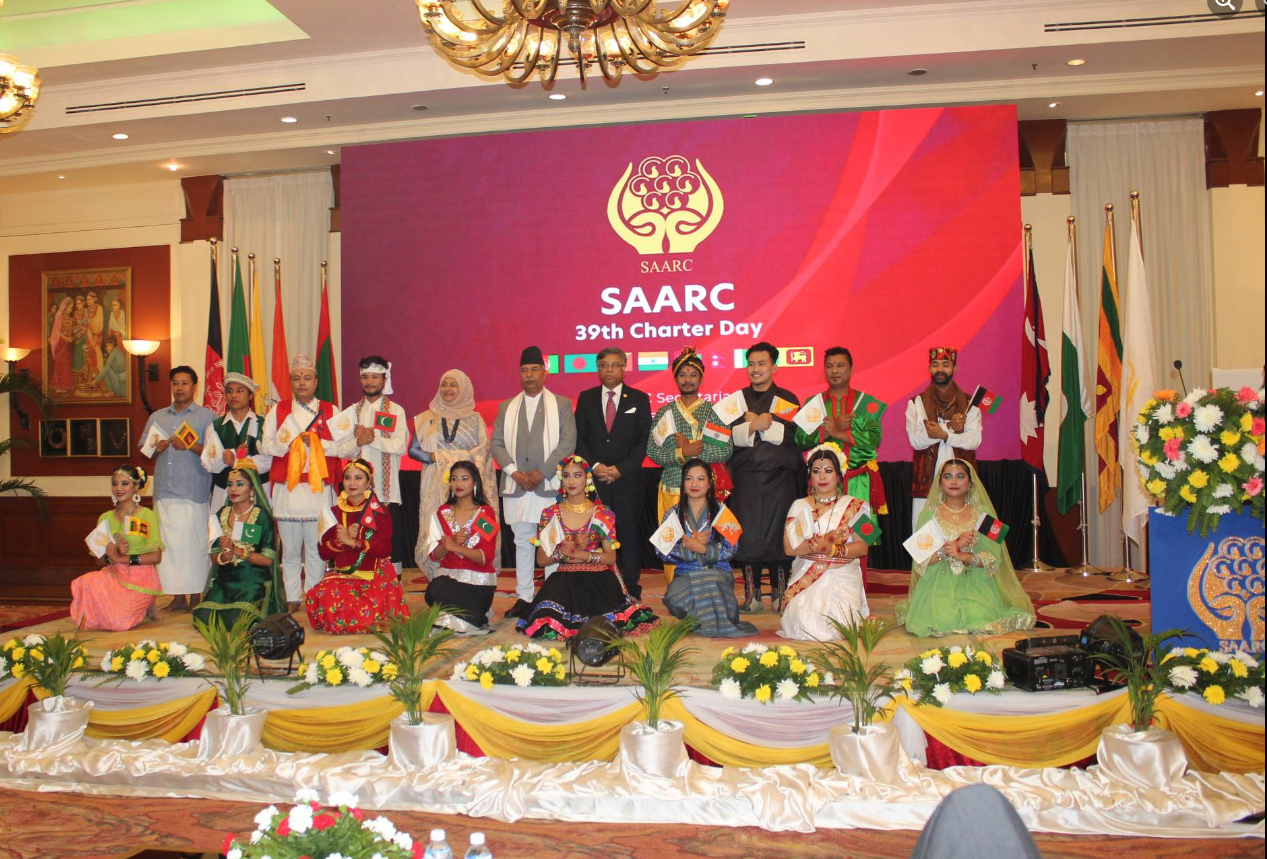 SAARC Charter Day in July 2024. [photo: SAARC Secretariat]
SAARC Charter Day in July 2024. [photo: SAARC Secretariat]
[This article is from The Round Table: The Commonwealth Journal of International Affairs.]
In recent days, India has experienced two incidents that underscore a significant contradiction in its foreign policy. On one hand, the successful organisation of the G20 Summit in India showcased the nation’s assertiveness and leadership within the Global South. However, juxtaposed against this achievement is the apparent weakening of India’s influence over the Maldives, a small island nation situated in the Indian Ocean. These divergent incidents shed light on India’s complex position in the intricate web of international relations. The nation finds itself at a crucial juncture, grappling with the delicate balance between its ambitions for global south leadership and the challenges posed by strained relationships with its South Asian neighbours, particularly within the South Asian Association for Regional Cooperation (SAARC).
India’s emergence as a global player has been marked by its aspirations to lead the nations of the Global South. With a robust economy, a burgeoning technological sector, and a rich cultural heritage, India has set its sights on becoming a pivotal player in shaping the narrative of the developing world. Leading initiatives like the International Solar Alliance (ISA) note the capability of India to unite third world countries under its umbrella. India’s influential role on the global stage positions it as a compelling candidate to advocate for the interests and concerns of the global south. However, the escalating tensions and strained relations with its immediate neighbours, especially within the SAARC countries, raise significant concerns for India.
From last few years, India’s relations with its South Asian nations, at some extent other than Sri Lanka, have faced major upheavals. The tumultuous relationships with neighbouring nations pose impediments to India’s global aspirations.
India’s Modi calls for African Union to join G20
India’s Influence in BRICS Is Waning
In the context of Afghanistan, India has significantly contributed to the country’s development through substantial financial investments over the years. However, the resurgence of the Taliban and their seizure of power has cast a shadow over the longstanding bilateral relations between India and Afghanistan. With Pakistan, historical animosities persist, exerting a significant influence on their bilateral relations. A recent example illustrating this ongoing tension is the dispute over the interpretation and modification of the Indus Water Treaty. This disagreement has brought to light the uneasy and strained situation between the two neighbouring nations.
The above-mentioned trend of diplomatic backlash reached an island in the Indian Ocean. The recent dispute between the Maldives and India has further exacerbated the already unstable relationship. However, it is essential to recognise that the major reason for this decline is the Chinese involvement in the Maldives. Moreover, the rise of Mohamed Muizzu, to the highest position in the Maldives seems to be creating troubles between the two neighbours. Given the Maldives’ strategic location in the Indian Ocean, the expanding Chinese influence in India’s backyard presents a significant challenge to India’s geopolitical interests
On the Eastern front, Bangladesh holds immense geopolitical significance for India. The ties between India and Bangladesh run deep, characterised by rich historical and cultural connections. Some notable milestones, in the form of the Land Boundary Agreement and the Kushiyara River Pact, mark a significant step forwards. However, amidst these achievements, issues such as increasing Chinese interventions, illegal migration, India’s Citizenship Amendment Act, and the contentious matter of Teesta water sharing continue to pose significant obstacles to the bilateral relations.
On the Himalayan front, the scars of the Madhesi blockade still linger in India-Nepal relations. Nepal perceived the Indian government’s involvement as unofficial support for the blockade, causing significant damage to bilateral ties and prompting Kathmandu to seek alternative alliances, notably with China. Over the years, China’s influence in Nepal’s political and economic spheres has experienced remarkable growth. To challenge India, Nepal initially brought attention to a disputed territory on its side on the map and, unprecedentedly, deployed troops along the Indian border. This marked a paradigm shift in the bilateral relations between the two neighbours.
Bhutan, another Himalayan state in the region, has been a steadfast ally of India since the signing of the friendship treaty in 1949. However, recent developments in Bhutan have raised concerns in India. Bhutan’s willingness to involve China as an equal partner in Doklam issue remains a major setback for India. This marks a significant departure from Bhutan’s previous stance and has added a new dimension to the ongoing strategic dispute over the Doklam region. Earlier, Bhutan had emphasised that no unilateral action should be taken near the existing trijunction point.
All things considered, it can be concluded that India should adopt a comprehensive strategy including expediting financial assistance to SAARC nations and leveraging its cultural affinity as a soft power asset, to amplify its influence in South Asia. By leading the revitalisation of SAARC, India can strengthen regional cooperation, consolidate its position in the region, and enhance its global stature.
Rahul M. Lad is Assistant Professor, Department of Geography, Sir Parshurambhau College, Pune, India.



